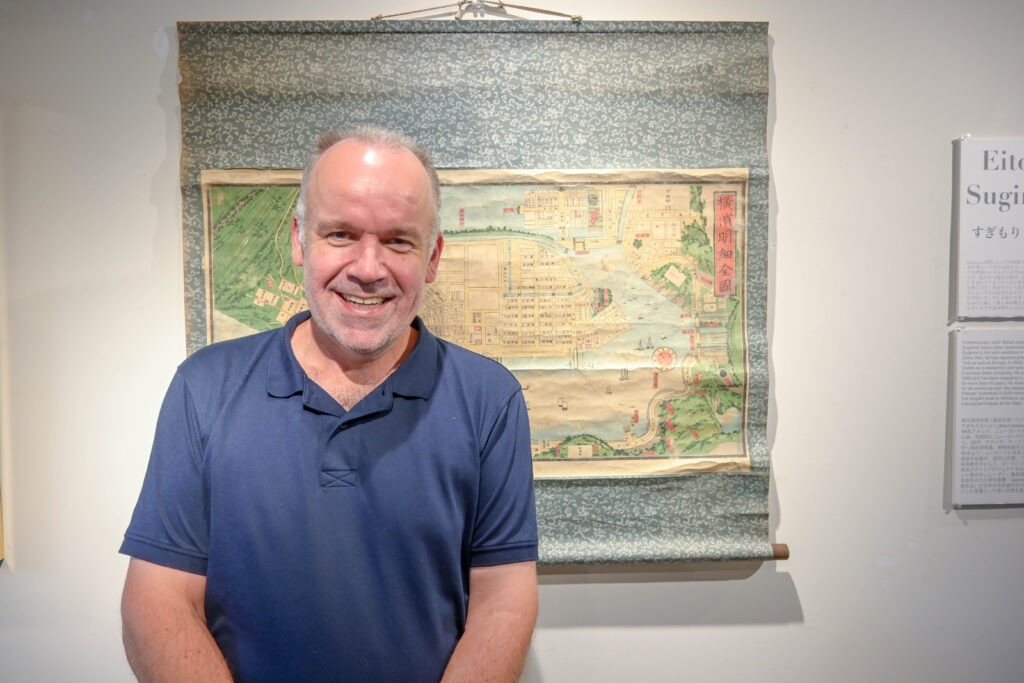What was your inspiration for establishing Bakumatsuya?
A history buff, I have always been interested in Japan, especially the period at the end of seclusion (sakoku) and Perry’s arrival. I was lucky enough to pursue my passion and secured a one-year working holiday in Osaka during my early twenties. After returning to Sydney, I searched bookstores for Japan-related materials and came across an old book that looked like it was printed on cloth. It was actually a Japanese fairy tale in English that was woodblock printed on so-called “crepe paper”. This was the first book that inspired me to become a collector. It was only after having lived in Japan for 20 or so years that I established Bakumatsuya in 2018.
Who are your clients and how do you reach them?
You would be surprised how many customers of booksellers are actually other booksellers. They are the only people in the world who actually have to buy books! They are the majority of my clients. Others include museum and university libraries both here in Japan and overseas, with the rest being private collectors. Although the idea of having a physical store is nice, the reality is that it just isn’t really necessary in these digital times so all items are on my website. I take up to 30 photos of each item so that potential buyers can clearly see what they may be purchasing. I also issue e-catalogues every month or two that get sent to my customers.
Can you elaborate on the requirements of being a bookdealer in Japan?
This is a very interesting question and quite an “only in Japan” kind of process.
First, one must join a “Bookdealers Association” in the area you live (or the area where you have a bookshop) and then for the first three months attend various auctions, help other dealers and most importantly, learn about how the traditional bidding system works. It may surprise some people but this system has continued for about 200 years where bids are written in pencil on paper and placed in an envelope. At a certain time, the envelope is emptied and all the paper bids are checked to find the highest bidder. During these first three months, there are certain restrictions, for example, limiting your attendance to only your local Bookdealers Association. Finally, after three months, a dealer is accredited and can take part in auctions anywhere in Japan.
What items do you actually deal in?
Mainly illustrated books from the 1600s to the 1930s, Japan-related photos dating from 1859 to 1900, old maps published in Japan before 1890, woodblock prints ideally with some Western theme or some English-language text, and rare manuscripts (books written by hand), as well as early English-Japanese dictionaries or phrasebooks.
What has been the rarest or most unusual item?
It is difficult to choose one, but I had a copy of Walter Henry Medhurst’s An English and Japanese, and Japanese and English Vocabulary: Compiled from Native Works, which was published in Batavia (present day Jakarta) in 1830. The book was actually printed by lithography, which was very difficult due to the humidity there, and the interesting thing is that Medhurst had never been to Japan (of course in 1830 no Westerners could) but he was helped by Chinese people along with some rescued Japanese fishermen who were stuck in Batavia and weren’t allowed to return to Japan. It was quite an achievement that Medhurst managed to publish such a book, and it ended up being sold to a private library in the US.
What Yokohama-related items have been popular?
Personally, I really like finding early Yokohama-related items. Woodblock printed maps of Yokohama (from 1859 to about 1870) are very nice and tend to sell well. Also, early guidebooks to Yokohama in English. The earliest known is from 1874 by William Elliot Griffis, although he only identifies himself as “A Resident” on the cover. I actually have a copy of that book available now. It is very scarce. Photos of Yokohama taken pre-1880 are also quite collectable and there are some really stunning examples.
Finally, what is your background and relation to Yokohama?
Due to my previous work, I moved to a suburb off the Denentoshi Line in 2002 and have lived on that line ever since. I have felt an affinity with Yokohama ever since I first visited the Yamate area and the Yokohama Foreign General Cemetery to see the graves of those Westerners who lived and died here long before us. When I have time, I still like wandering around that area and I also enjoy going to the Yokohama Archives of History to find out more about the authors of some of the items that pass through my hands.


